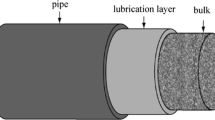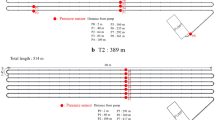Abstract
The rheology of concrete is predominant for the required pressures in a pumping pipe. However, more detailed information is required on the formation and the properties of the lubrication layer near the pipe surface, in order to be able to accurately predict the pressure-discharge relation. By means of experimental research in combination with advanced numerical simulations, the lubrication layer near the surface of the concrete pipe has been studied in this paper. The research confirms the existence and the effects of the lubrication layer on the movement of concrete in a pumping pipe. By means of the particle image velocimetry technique, the velocity profile along the cross section has been accurately determined for different types of concrete. There is no real slip at the surface of the pipe, however the velocity profile steeply grows in a thin layer, called lubrication layer, showing a thickness of about 2 mm. The mortar in this layer, with lower yield stress and lower viscosity than the bulk concrete, is highly sheared. The bulk of the concrete is sheared and/or shows a plug flow, depending on the yield stress of the concrete. The stiffer the concrete, the more important the effect of the lubrication layer on the overall velocity profile. In most cases, the lubrication layer is the dominant effect for pumping of concrete. Shear of the bulk concrete only plays a significant role for more fluid concretes.












Similar content being viewed by others
References
Roussel N (2007) Rheology of fresh concrete: from measurements to predictions of casting processes. Mater Struct 40(10):1001–1012
Feys D, Khayat KH (2013) Comparing rheological properties of SCC obtained with the ConTec and ICAR rheometers. In: International North American conference on the design and use of self-consolidating concrete. Chicago, p 429
Le HD, De Schutter G, Kadri EH, Aggoun S, Vierendeels J, Tichko S, Troch P (2013) Computational fluid dynamics calibration of Tattersall MK-II type rheometer for concrete. Appl Rheol 23:34741
Wallevik JE (2009) Developement of parallel plate-based measuring system for the contec viscometer. In: RILEM international symposium on rheology of cement suspensions such as fresh concrete. Chicago, USA
Feys D, Verhoeven R, De Schutter G (2007) Evaluation of time independent rheological models applicable to fresh self-compacting concrete. Appl Rheol 17(5):56244–57190
Tattersall GH, Banfill PJG (1983) The rheology of fresh concrete. Pitman, Boston
Hu C, de Larrard F, Sedran T, Boulay C, Bosc F, Deflorenne F (1996) Validation of BTRHEOM, the new rheometer for soft-to-fluid concrete. Mater Struct 29(194):620–631
Golaszewski J, Szwabowski J (2004) Influence of superplasticizers on rheological behaviour of fresh cement mortars. Cem Concr Res 34(2):235–248
Wallevik JE (2006) Relationship between the Bingham parameters and slump. Cem Concr Res 36(7):1214–1221
Kaci A, Chaouche M, Andreani PA, Brossas H (2009) Rheological behaviour of render mortars. Appl Rheol 19(1):13794
Feys D, Verhoeven R, De Schutter G (2009) Why is fresh self-compacting concrete shear thickening? Cem Concr Res 39(6):510–523
de Larrard F, Ferraris CF, Sedran T (1998) Fresh concrete: a Herschel-Bulkley material. Mater Struct 31(7):494–498
Mélinge Y, Hoang VH, Rangeard D, Perrot A, Lanos C (2013) Tribological study of a fresh mortar and rigid plane wall under simple shear flow. Eur J Environ Civ Eng 17:419–429
Morinaga M (1973) Pumpability of concrete and pumping pressure in pipeline. In: Proceedings of a RILEM seminar on fresh concrete: important properties and their measurement, 22–24 March, vol 7. Leeds, pp 1–39
Bleschik NP (1977) Structural and mechanical properties and rheology of the concrete mixtures and vacuum concrete. Nauka i Technika (Minsk), p 232
Best JF, Lane RO (1980) Testing for optimum pumpability of concrete. Concr Int 2(10):9–17
Kaplan D (2000) Pompage des bétons. In: Laboratoire Central des Ponts et Chaussées. Ecole Central des Ponts et Chaussées
Chapdelaine F (2007) Étude fondamentale et pratique sur le pompage du béton. In: Faculté des études supérieures de l′Université Laval. Université Laval, Laval
Ngo TT, Kadri EH, Bennacer R, Cussigh F (2010) Use of tribometer to estimate interface friction and concrete boundary layer composition during the fluid concrete pumping. Constr Build Mater 24(7):1253–1261
Feys D, Khayat KH (2013) Relation between rheological and tribological properties of highly-workable concrete, in view of estimating pumping pressure. In: International North American conference on the design and use of self-consolidating concrete. Chicago, p 430
Ngo TT (2009) Influence de la composition des bétons sur les paramètres de pompage et validation d’un modèle de prévision de la constante visqueuse. University of Cergy Pontoise, France
Kalyon DM (2005) Apparent slip and viscoplasticity of concentrated suspensions. J Rheol 49(3):621–640
Yilmazer U, Kalyon DM (1989) Slip effects in capillary and parallel disk torsional flows of highly filled suspensions. J Rheol 33(8):1197–1212
Kalyon DM, Yaras P, Aral B, Yilmazer U (1993) Rheological behavior of a concentrated suspension—a solid rocket fuel simulant. J Rheol 37(1):35–53
Banfill PFG (2006) Rheology of fresh cement and concrete. Rheol Rev 2006:61
Willert CE, Gharib M (1991) Digital particle image velocimetry. Exp Fluids 10(4):181–193
Blanc F, Peters F, Lemaire E (2011) Particle image velocimetry in concentrated suspensions: application to local rheometry. Appl Rheol 21(2):23735
Kays WM, Crawford ME (1993) Convective heat and mass transfer, 3rd edn. McGraw-Hill, New York
Kakaç RK, Shah RK, Aung W (eds) (1987) Handbook of single-phase convective heat transfer, chap 3. Wiley-Interscience, New York
Nouar C, Bottaro A (2010) Stability of the flow of a Bingham fluid in a channel: eigenvalue sensitivity, minimal defects and scaling laws of transition. J Fluid Mech 642:349–372
Madlener K, Frey B, Ciezki HK (2009) Generalized reynolds number for non-newtonian fluids. In: Progress in propulsion physics. EDP Sciences, Brussels, pp 237–250
Jana SC, Kapoor B, Acrivos A (1995) Apparent wall slip velocity coefficients in concentrated suspensions of noncolloidal particles. J Rheol 39(6):1123–1132
Soltani F, Yilmazer U (1998) Slip velocity and slip layer thickness in flow of concentrated suspensions. J Appl Polym Sci 70(3):515–522
Spangenberg J, Roussel N, Hattel JH, Stang H, Skocek J, Geiker MR (2012) Flow induced particle migration in fresh concrete: theoretical frame, numerical simulations and experimental results on model fluids. Cem Concr Res 42(4):633–641
Spangenberg J, Roussel N, Hattel JH, Sarmiento EV, Zirgulis G, Geiker MR (2012) Patterns of gravity induced aggregate migration during casting of fluid concretes. Cem Concr Res 42(12):1571–1578
Koh CJ, Hookham P, Leal LG (1994) An experimental investigation of concentrated suspension flows in a rectangular channel. J Fluid Mech 266:1–32
Lyon MK, Leal LG (1998) An experimental study of the motion of concentrated suspensions in two-dimensional channel flow. Part 1. Monodisperse systems. J Fluid Mech 363:25–56
Morris JF, Brady JF (1998) Pressure-driven flow of a suspension: buoyancy effects. Int J Multiph Flow 24(1):105–130
Feys D (2009) Interactions between rheological properties and pumping of self-compacting concrete. In: Magnel laboratory for concrete research, Ghent University, Ghent
Chapdelaine F, D. Beaupré D (2002) Eléments de réponse face aux problèmes de pompabilité du béton. In: Material specialty conference of the canadian society for civil engineering. Montréal, Canada
Jolin M, Burns D, Bissonnette B, Gagnon F, Bolduc LS (2009) Understanding the pumpability of concrete. In: Shotcrete for underground support XI, ECI Symposium Series, vol P11. Davos, Switzerland
Author information
Authors and Affiliations
Corresponding author
Rights and permissions
About this article
Cite this article
Le, H.D., Kadri, E.H., Aggoun, S. et al. Effect of lubrication layer on velocity profile of concrete in a pumping pipe. Mater Struct 48, 3991–4003 (2015). https://doi.org/10.1617/s11527-014-0458-5
Received:
Accepted:
Published:
Issue Date:
DOI: https://doi.org/10.1617/s11527-014-0458-5




